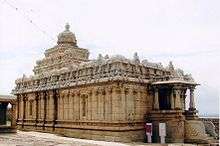Chavundaraya Basadi
Chavundaraya basadi or Chamundaraya basadi or Boppa-Chaityalya is one of the fifteen basadis located on the Chandragiri Hill in Shravanabelagola in the Indian state of Karnataka.[1]
| Chavundaraya Basadi | |
|---|---|
 Chavundaraya Basadi at Shravanabelagola | |
| Religion | |
| Affiliation | Jainism |
| Deity | Neminatha |
| Festivals | Mahavir Jayanti |
| Governing body | Shri Shravana Belgola Jain Matha |
| Location | |
| Location | Shravana Belgola, Hassan, Karnataka |
| Geographic coordinates | 12°51′42.19″N 76°29′12.38″E |
| Architecture | |
| Style | Dravidian architecture |
| Creator | Chavundaraya |
| Date established | 982 AD |
History
Chavundaraya basadi was erected by Chavundaraya during the rule Ganga King Marasimha II and completed by Chavundaraya's son Jinadeva. The idol of Neminatha, flanked by Chauri bearers, is believed to installed by Hoysala period attributing to the characteristics matching Hoysala art.[2] The temple underwent improvement in 12th century under the rule of Chola Empire.[3] The pyramidal shikhara crowned with domical finial is example of Chola architecture.[4] In c. 12th century CE, a pillared porch was added to the temple complex.[3]
Architecture
Chavundaraya basadi along with Suparshwanath, Kattale and Chandragupta basadi is considered the most important for the architecture in Jain temple complex of Chandragiri Hill[2][5] with Chavundaraya basadi as most the finest and largest.[4][6][7] This temple is built in Dravidian architecture and famous for its workmanship.[3] The temple houses a garbhagriha, pradakshinapatha, open sukansi, navaranga and mukhamandapa. Above the garbagriha is a dvitala vimana.[2] The garbhagriha houses an idol of Neminatha flanked by Chauri bearers and the one first floor of the vimana houses the image of Parshavanatha installed by Jinadeva in 985 CE.[8]
Chavundaraya basadi is a 68 by 36 feet (21 m × 11 m) two-story shrine with a shikhara built in Dravidian style. This temple is the largest shrine in Shravanabelagola with ornamental niches with figures of yakshi and Jain monks in padmasan posture. The build Western Gangas style. The architecture of this temple was influenced from Chalukyan style in Aihole and Badami temple complex.[5] The mulnayak of the temple is an black colored idol of Neminatha. The temple also houses an idol of Ambika seated under a mango tree with amra-lumbi (mango tree branch) in right hand and citron in left.[9]
Protection
The temple is protected as a monument of national importance by the Archaeological Survey of India.[3]
See also
| Wikimedia Commons has media related to Chavundaraya Basadi. |
- Shantinatha Basadi, Jinanathapura
- Akkana Basadi, Shravanabelagola
References
Citations
- Chugh 2016, p. 313.
- Chugh 2016, p. 282.
- ASI & Chamundaraya Basti, Sravanabelagola.
- Reddy 2009, p. 126.
- Deccan Herald & Holy hills beckon.
- Publications Division & Temples of South India.
- Deccan Herald & The rite sacred bath.
- Chugh 2016, pp. 282-283.
- Shah 1987, p. 250.
Sources
- Chugh, Lalit (2016), Karnataka's Rich Heritage - Art and Architecture: From Prehistoric Times to the Hoysala Period, 6, Notion Press, ISBN 9789352068258
- Reddy, V. V. Subba (2009), Temples of South India, Gyan Publishing House, ISBN 9788121210225
- Shah, Umakant Premanand (1987), Jaina-rūpa-maṇḍana, 1, Abhinav Publications, ISBN 9788170172086
- Publication Division (2017). Temples of South India. Publications Division Ministry of Information & Broadcasting. ISBN 9788123025728.
- "Chamundaraya Basti, Sravanabelagola". Archaeological Survey of India.
- "Holy hills beckon". Deccan Herald. 4 May 2019.
- "The rite sacred bath". Deccan Herald. 12 February 2019.
.jpg)

